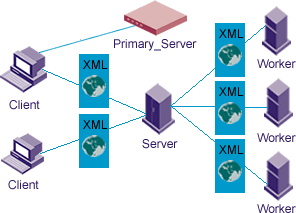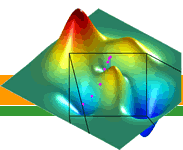| |
 ROS (Remote Optimizaton Service) is a system designed in order to facilitate the execution of optimization algorithms by remote way.
It is compound of several types of distributed services in a (LAN/WAN) network, which establish connection to interchange the information referring to the configuration and manipulation of these algorithms through Internet. ROS (Remote Optimizaton Service) is a system designed in order to facilitate the execution of optimization algorithms by remote way.
It is compound of several types of distributed services in a (LAN/WAN) network, which establish connection to interchange the information referring to the configuration and manipulation of these algorithms through Internet. |
|
| |
 By means of this service, we can select the algorithms and servers, and once connected with them, to introduce the parameters and initiate an execution respect to a remote machine (where the algorithms are lodged), so that once end, gives back the obtained results and shows them. By means of this service, we can select the algorithms and servers, and once connected with them, to introduce the parameters and initiate an execution respect to a remote machine (where the algorithms are lodged), so that once end, gives back the obtained results and shows them. |
|
| |
 ROS offers us a Client GUI application which we can establish the communication with the different distributed servers in the network. These servers provide us information about the structure of the network, the necessary types of algorithms
including as well as the data and parameters. In addition, it's make the lodging and manipulation of these algorithms.
Down (Figure 1), we can see a sumarized scheme of the ROS structure. ROS offers us a Client GUI application which we can establish the communication with the different distributed servers in the network. These servers provide us information about the structure of the network, the necessary types of algorithms
including as well as the data and parameters. In addition, it's make the lodging and manipulation of these algorithms.
Down (Figure 1), we can see a sumarized scheme of the ROS structure. |
|
| |

Figure 1. ROS structure
|
|
| |
 As it show, the different kinds of machines interact to each other sending and recieving the
information contained in XML files which are generate in each process step: As it show, the different kinds of machines interact to each other sending and recieving the
information contained in XML files which are generate in each process step:
- Client. It provides a graphical interface, by means of, a user controls the execution process. Its main function is the one to gather parameters and to show results at the end of each cycle of execution.
- Primary Server. It provides information about the rest of the system to the client, in addition it manages the incomming of users.
- Server. It distributes and manages the information flow.
- Worker. It manipulates the algorithms and controls its executions.
| |
|
 Software
and Documentation:
NOTE Software
and Documentation:
NOTE
You
may need to install a Java 1.1.8 (or later) virtual machine.
You can download one from Sun's
Java web site . |
|
| |
 Other Links: Other Links:
|
|
|





